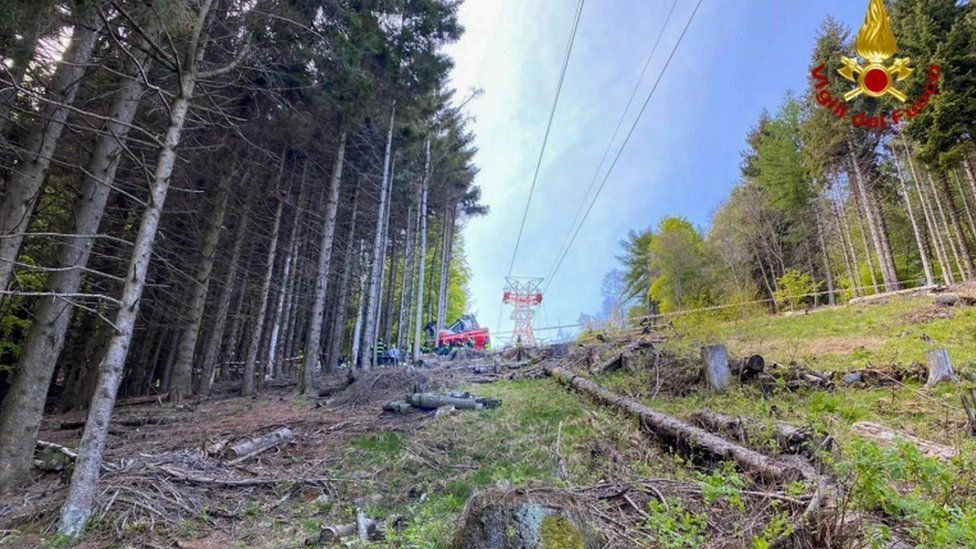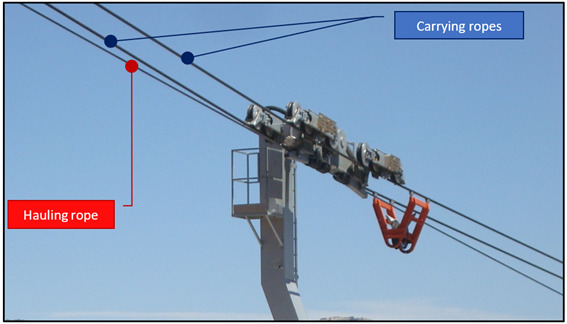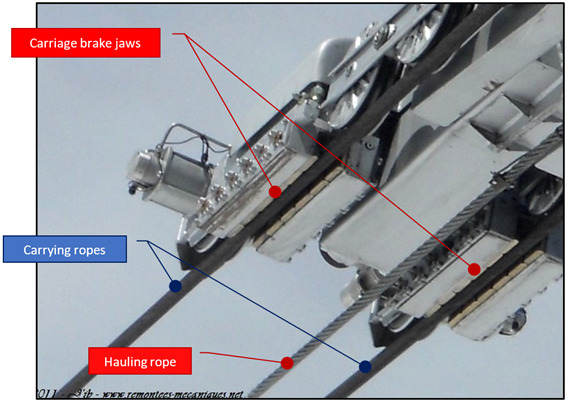
Stresa – Alpino – Mottarone Cable Car Accident
This week, we would like to extend our deepest condolences to the families of the victims of the sad accident of the Stresa – Alpino – Mottarone cable car.
We want to make our brief summary of what happened, although it is clear that the conclusions on the causes of the accident can only be confirmed after the ongoing technical investigation.
The cable car is a reversible aerial ropeway, consisting of 2 independent sections, with cabins of 35 passengers. It was inaugurated in 1970 and built by Piemonte Funivie (now disappeared). In 2002, it was extensively inspected by POMA Italia (later Agudio) and was recently undergone a complete renovation by Leitner between 2014 and 2016.
According to witnesses, at approximately 12:30 p.m. on 23/05/2021, they heard a noise followed by a hissing sound and saw one of the cabins start going backwards at high speed until it reached the first pylon where it derailed and fell to the ground.
This could not have happened (and we insist on the conditional, because until the ongoing investigation is completed, no hypothesis can be confirmed) if two simultaneous failures have occurred:
- – breaking the tractor cable
- – carriage brake failure
To better understand what we are doing, and for the uninitiated, we recall here the operation of a cable car like the one in Stresa: the vehicles travel on 1 or 2 fixed carrier cables; it is another cable, called “tractor”, which is responsible for moving the vehicles: 
If the tractor cable breaks, the vehicle would no longer be towed and would therefore reverse without control. To mitigate this risk, the vehicle trolleys are equipped with a brake that activates in the event of a tractor failure, releasing jaws that stop the vehicle, by rubbing on the carrier cables. 
Apparently, during last Sunday’s sad accident, the trolley brake did not act because the operating company would have taken it out of service due to operational problems.
The investigation will then have to explain why the hauling rope broke, given that, as published in the press, it has been subjected to a magnetographic inspection in November 2020.
Despite this sad accident, we want to say that cable transportation is one of the safest transportation systems. To illustrate this statement, we want to list the fatal accidents that have occurred over the past 70 years:
- – 1957 – Cogne: the vehicle of a cable car carrying mine personnel fell, killing 1 person and injuring 11.
- – August 15, 1960 – Monte Faito: the vehicle of the cable car detached and fell on the railway line that runs under the line: 4 dead.
- – August 29, 1961 – Mont Blanc: a French fighter plane cuts the rope of the cable car between Hellbronner Point and Aiguille du Midi. It killed six people.
- – July 10, 1966 – Mont Blanc: five years after the 1961 accident, a problem in the suspended tower of the cable car between Hellbronner Point and Aiguille du Midi caused the fall of the 3 cabins, killing 1 and injuring 13.
- – March 9, 1976 – Cermis: The failure of a carrying rope caused a cabin to fall, killing 42 people.
- – February 13, 1983 – After an incident, the lift untimely began to move, causing the rope to break, dropping three cabins to the ground. Balance: 11 deaths.
- – November 6, 1985 – Madonna de Campiglio: During maintenance work, the cabins crashed into the stations, causing the death of one of the cable car workers. It was probably a human error.
- – March 1, 1987 – Luz Ardiden: During a busy day of skiers, the arrival station of a chairlift was torn off, causing almost all chairs to fall. Result: 7 dead. The investigation revealed bad execution of the foundation and led to regulatory reform for the construction of cable cars in France.
- – 1988 – Val Nola: Due to a technical problem, the cable car started the journey before the doors closed. Three passengers threw themselves into the void because of panic, and one of them died of his injuries.
- – January 13, 1989 – Vaujany: apparently, because of the bad assembly of the carriage on the vehicle, it rushed to the ground, leaving a sad record of 8 technicians of the company in charge of the design and construction of the cable car.
- – August 30, 1994 – Courmayeur: an accident similar to that of Stresa. In this case, the only occupant of the vehicle to detach was the operator of the lift, who died in the accident. The other cabin, carrying 24 passengers, was stopped by the carriage brake and the occupants were safely rescued.
- – February 3, 1998 – A U.S. military plane severed a cable car, killing 20 people.
- – July 1, 1999 – Bure Peak: The hauling rope rupture caused the cab to roll back and derailed and fell to the ground. The accident killed 20 people.
- – November 11, 2000: A fire inside the Kaprun funicular tunnel killed 155 people.
- – September 5, 2005 – Near Soelden: A helicopter accidentally dropped an 800 kg concrete block, killing nine skiers.
- – March 1, 2008 – Chamonix: A vehicle occupant rushed to the ground after a polycarbonate got out and fell to the ground. They were apparently young men bickering inside the cabin.
Statistics from Switzerland, the country in the world where cable cars use is the most widespread among the population, show that this is the safest transport compared to other transport technologies. Statistically, cable car passengers have:
- – 3 times less likely to be injured than on the tram, bus or train.
- – 50 times less likely to be injured than in a car
Finally, we would like to conclude that the accidents listed has changed both regulations and safety techniques in ropeways and that almost all of the examples cited could not occur on modern lifts. For our part, we will continue to apply the strictest rigor of our work, as we have always done.
For more information on regulations, technology, or any other technical topic, you can contact us at semsa@semsa.ad



